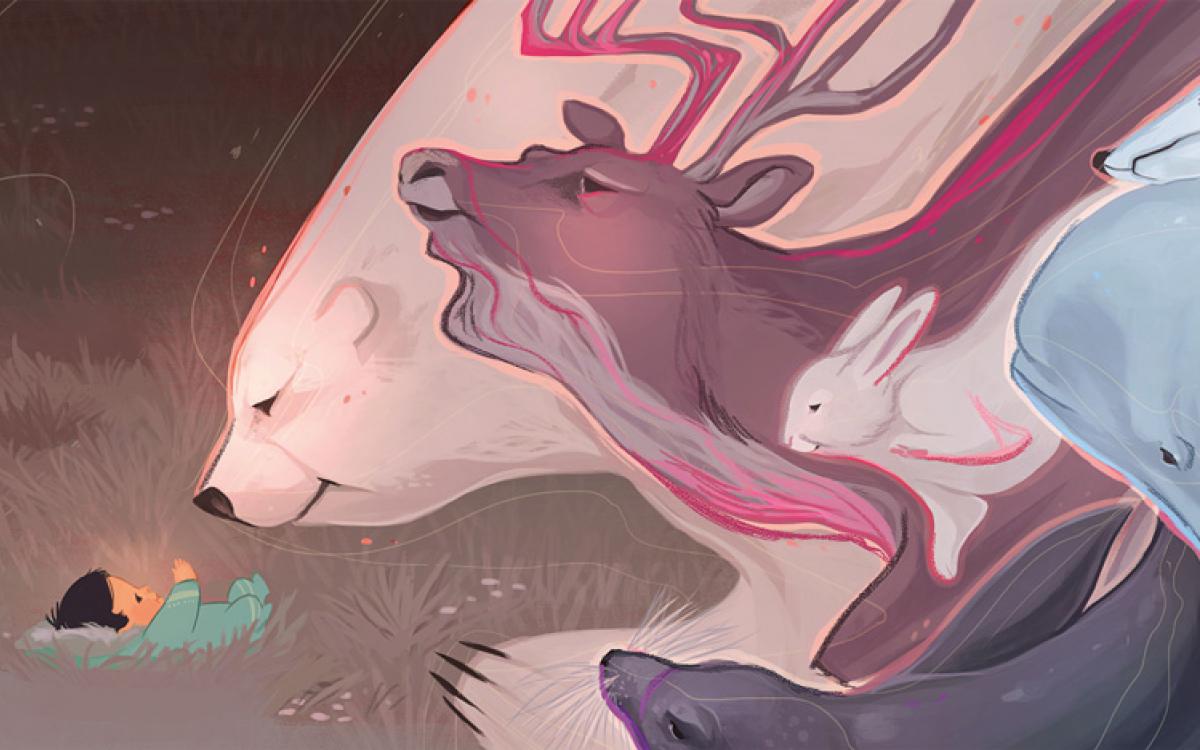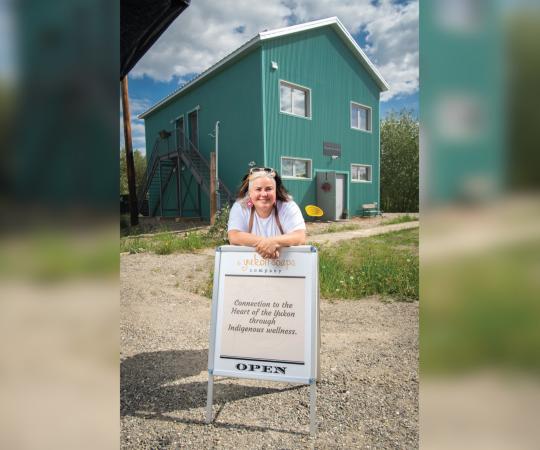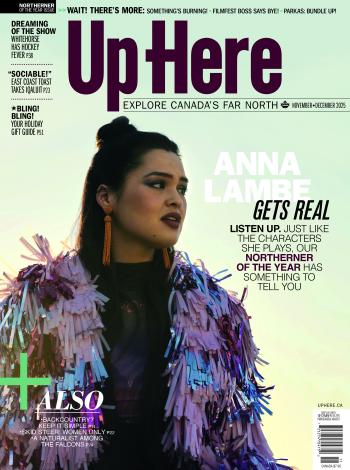Trust: you gotta have it in your product, in your market and in the skills of your own people. But for an independent publishing company with a mandate to preserve and promote Inuit and Northern culture through the telling of Arctic legends, myths and adventures, gaining the trust of the people who hold that knowledge—who can tell those stories—is paramount.
Neil Christopher, co-founder of Inhabit Media with Louise Flaherty and his brother Danny, says they were given the benefit of the doubt early on. “I think a lot of times in the past, people just took stories from other people and that’s one of the things we wanted to do differently,” he says, noting government publications often took copyright—basically ownership—of stories. “When we came on, we knew that authors should own their stories, and publishers should be paying for the right to use those stories,” he says. “If the books did well, they should get a cut—the royalty—just like any author would.” Authors who publish with Inhabit Media get two reports per year that chart a book’s sales. Once their advance is paid off, they start receiving royalties—though, admittedly, no book has sold well enough yet for a writer to consider quitting their day job.
But trust isn’t built overnight. Christopher moved North 20 years ago and taught in Resolute Bay, where one of his favourite books was How Kabloonat Became and Other Inuit Legends, published by the GNWT in 1974, and written by the late Mark Kalluak from Arviat. When Flaherty and the Christopher brothers decided to seriously pursue the publishing venture, it was working with Kalluak that really got the ball rolling.
“We wanted Northern kids to have the chance to read stories where they saw characters like themselves in settings like the settings they lived in. Because we felt the absence of those kinds of stories in a child’s life almost makes it seem like their place is not an adventurous place or an important or cool place.”
As Christopher tells it, Kalluak was frustrated with how the government had treated his stories. This worked for and against Inhabit Media: he was reluctant to publish any more work, but he was receptive to new ways of getting his stories out there. “He was an Order of Canada recipient, a very respected man, and he trusted us with his collected work,” says Christopher. They published two collections of Kalluak’s work and were working with him on a third when he passed away. “Things really changed after we worked with Mark. We started to get more elders contacting us saying, ‘We have a story,’ or their children contacting us.”
Kalluak had an urgent need to share his knowledge, stating in an online interview before his passing: “I wrote these stories because I knew that they would disappear because life is changing and people don’t listen to stories from their grandparents anymore. If more kids knew the traditional stories, they’d be more knowledgeable. These stories help you to think about how you should behave among other people.”
That’s basically the mission statement for Inhabit Media. Its focus is on children’s books—educational stories, tales passed down for generations by elders, or tales pulled out of lived experience—in Inuktitut, English, even French. “We wanted Northern kids to have the chance to read stories where they saw characters like themselves in settings like the settings they lived in,” says Christopher. “Because we felt the absence of those kinds of stories in a child’s life almost makes it seem like their place is not an adventurous place or an important or cool place.”
Inhabit Media takes pitches from authors, but also finds storytellers through unconventional means. Christopher, for example, worked with the Nunavut Teacher Education Program at Nunavut Arctic College: “I had an unfair advantage of being on the inside and seeing these students and some of them were brilliant writers,” he says. Marion Lewis, author of Kaugjagjuk, released in 2011, wrote a short assignment for him, and “I realized this woman has a gift for writing.” Celina Kalluk, author of Sweetest Kulu, one of Inhabit’s most popular titles, was a high school student of Christopher’s.
“We wanted young Canadian and American children to see what it’s like living up here and maybe when they grow up, they’re going to have more sensitivity or more interest in learning about the North before they make political decisions that harm the North.”
The editing process can be tense at times. Many of the writers are very gifted storytellers, but first-time authors. And since the published stories are close to the author and to Inuit, writers can be sensitive to suggested changes. That’s why making authors comfortable with the final product is vital. “We’re very accountable to our community. We’re not like a publisher that’s provinces away or anything like that. We have to look at people in the eyes. We want to make sure that at the end of a publishing project ... everyone’s happy and proud and they feel that we’ve honored their story or treated their story with the respect and attention that it deserves. I think having our head office in Iqaluit keeps us honest.”
Inhabit Media has two offices, in fact: one in Iqaluit with up to five employees, and another in Toronto that employs three. Both are necessary and, in a way, they’ve flipped the typical North-South relationship around: big companies often open a small, satellite office in the North to take advantage of local government subsidies. “We’re actually the opposite,” says Christopher. A slumping industry enabled them to scoop up southern publishing pros with connections, to make up for a lack of publishing know-how in Iqaluit. This has opened doors to U.S., Australian and U.K. markets. “We have to get staff to go periodically to sales meetings,” says Christopher. “That’s just unrealistic from Iqaluit. That’s a very expensive trip down.”
But the Iqaluit office is where much of the content creation comes from, where freelancers can work for months on end. To keep both offices connected, Iqaluit staff are encouraged to spend time at the Toronto office whenever they travel south to visit family; likewise, one Toronto staff member works in Iqaluit for up to five months each year.
The company is really pushing to get into southern markets—an audience not always on the Northern radar. “It’s great when we can start bringing money that was never intended for the North, never even intended for Canada, back into our country, back into the North,” says Christopher. “That’s the great thing about this model: the better we do, the better our community is doing. The more money we’re putting into the community, the more people we’re hiring—translators, illustrators—and the more royalties there are coming back into the communities based on sales.”
And by telling stories about traditional lifestyles in the North—including tales about, say, seal hunting—they can educate outsiders. “We wanted young Canadian and American children to see what it’s like living up here and maybe when they grow up, they’re going to have more sensitivity or more interest in learning about the North before they make political decisions that harm the North.”
Inhabit Media is releasing six children’s books this fall, and starting next spring it will put out a slate of books, designed to fall within prescribed literacy levels for school reading programs. The company is also looking to get into interactive and animated digital storytelling, and has even expanded into films—releasing its own short film in 2013. “We’ve received some critical acclaim on what we’ve done, but I can tell you, we’ve not made money on anything we’ve done on the film side,” says Christopher.
But he trusts in the model. And now nearly 10 years in, with more than 80 titles to its name, Inhabit Media continues to pen its own story of persistence and survival.
Feeling bookish?
A couple of Inhabit Media titles fresh off the press
With no culture of recording or writing fictional stories, Inhabit Media has come up with some artful ways over the years to tell stories and pass on traditional knowledge to the next generations of Northerners.

Kamik’s first sled
by Matilda Sulurayok, illustrations by Qin Leng
This is the second story in a series about Jake and his puppy Kamik. The first book, Kamik: An Inuit puppy story, came out of interviews for an academic-minded book about Inuit and their
relationships with dogs. “All these people we were interviewing had tremendously interesting stories,” says Christopher. “[We] said, ‘can we take your story—your actual experience—and get you to help us write it with fictional characters?’” Arviat elder Donald Uluadluak’s anecdotes from his youth were adapted to become the basis of a tale about a disobedient puppy, with Uluadluak playing the role of the fictional grandfather in the first book, teaching Jake how to make Kamik listen to him. In the latest installment, Kamik’s First Sled, Matilda Sulurayok of Arviat provides the story, detailing how to train a puppy to start pulling a sled.

A Walk on the shoreline
by Rebecca Hainu, illustrations by Qin Leng
In this story, Nukappia, a young boy, walks along the beach to a family camp with his uncle, who points out various animals and plant species, explaining their traditional Inuit uses. It follows A Walk on the tundra, where an elder teaches her granddaughter about the importance of the land. The stories were based on interviews with Hainu’s family, about how they would pass on such knowledge. “For us, it’s always problem-solving and working with authors, storytellers and knowledge-holders, about what’s the best way to get this out,” says Christopher. “How do we speak to the younger generation that might not sit and listen to an hour-long conversation on plants, but maybe they’ll read a story on plants that’s infused with the knowledge the elder wants to move forward.”










